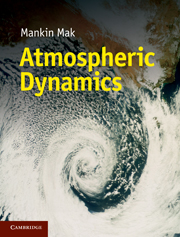Book contents
- Frontmatter
- Contents
- Preface
- 1 Fundamental concepts and physical laws
- 2 Basic approximations and elementary flows
- 3 Vorticity and potential vorticity dynamics
- 4 Friction and boundary layers
- 5 Fundamentals of wave dynamics
- 6 Quasi-geostrophic theory and two-layer model
- 7 Dynamic adjustment
- 8 Instability theories
- 9 Stationary planetary wave dynamics
- 10 Wave-mean flow interaction
- 11 Equilibration dynamics of baroclinic waves
- 12 Nongeostrophic dynamics
- Appendix: Mathematical tools
- References
- Index
- Plate section
6 - Quasi-geostrophic theory and two-layer model
Published online by Cambridge University Press: 05 June 2012
- Frontmatter
- Contents
- Preface
- 1 Fundamental concepts and physical laws
- 2 Basic approximations and elementary flows
- 3 Vorticity and potential vorticity dynamics
- 4 Friction and boundary layers
- 5 Fundamentals of wave dynamics
- 6 Quasi-geostrophic theory and two-layer model
- 7 Dynamic adjustment
- 8 Instability theories
- 9 Stationary planetary wave dynamics
- 10 Wave-mean flow interaction
- 11 Equilibration dynamics of baroclinic waves
- 12 Nongeostrophic dynamics
- Appendix: Mathematical tools
- References
- Index
- Plate section
Summary
This chapter discusses the single most important theory in dynamic meteorology for large-scale flows in the extratropics. It is known as the quasi-geostrophic theory. One example of such flow is briefly presented in Section 6.1 for the uninitiated readers. Section 6.2 discusses a method known as scale analysis for estimating the order of magnitude of each term of a governing equation. Such analysis is applied in Section 6.3 to derive a simplified version of the complete set of governing equations, known as the quasi-geostrophic (QG) system of equations. In Section 6.4, we combine them to get a diagnostic equation that highlights the symbiotic relationship between the rotational and divergent wind components. The QG system of equations is next reduced to one prognostic equation for a single unknown in Section 6.5. Not surprisingly, that is the QG version of the potential vorticity equation. We verify that only Rossby waves could exist in a QG model in Section 6.6. Section 6.7 shows the formulation of a two-layer version of the QG model, which will be used extensively throughout the book. Here we apply it to quantitatively illustrate all concepts encountered so far in the context of a developing baroclinic jet streak. Finally, Section 6.8 discusses how a QG model is cast in a global spherical domain.
Observed features of a synoptic disturbance
Disturbances with a horizontal dimension of the order of a thousand kilometers are ubiquitous in the extratropical atmosphere. They are referred to as synoptic-scale cyclones/ anticyclones.
- Type
- Chapter
- Information
- Atmospheric Dynamics , pp. 153 - 186Publisher: Cambridge University PressPrint publication year: 2011



